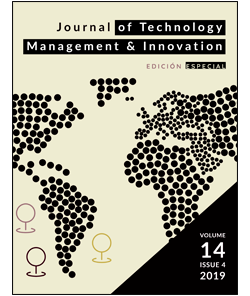The Impact of Cooperation on Business Innovation in Developing Countries: Evidence from Chile Latin America
DOI:
https://doi.org/10.4067/S0718-27242019000400031Keywords:
Business Innovation, Cooperation, Developing CountryAbstract
There is abundant empirical evidence supporting the relationship between cooperation and innovative entrepreneurial activity, but the conversation continues to be limited to the context of developing countries. This study contributes to the academic debate on this topic with an empirical evaluation of the effect of cooperation networks on innovation, using Chile in Latin America as a case study. Furthermore, while previous studies mainly refer to technological innovations in a particular industrial sector, in this paper we will build an innovation measurement system that incorporates both technological and non-technological activities among diverse industrial sectors. Upon applying cross-sectional data from a national survey on innovation in a developing firm from two different years to a zero-inflated negative binomial regression, we found that a business that reports on cooperation conducts more innovative activities per year compared to one that does not. The type of agent that a business cooperates with is also relevant in this context; other businesses, clients, and consultants showed stronger and more stable results than other types of agents. This evidence is relevant as it presents new information about the importance of the type of agent that a business cooperates with in the context of developing countries.
Downloads
References
Acs, Z., & Audretsch, D. (1988). Innovation in Large and Small Firms: An Empirical Analysis. American Economic Review, 78(4), 678–690.
De Faria, P., & Schmidt, T. (2012). International cooperation on innovation: Firm-level evidence from two European countries. Innovation, 14(3), 303–323. http://doi.org/10.5172/impp.2012.14.3.303
de Mel, S., McKenzie, D., & Woodruff, C. (2009). Innovative Firms or Innovative Owners? Policy Research Working Paper. Retrieved from http://documents.worldbank.org/curated/en/276891468166787383/pdf/WPS4934.pdf
Dyer, J. H. (1996). Specialized Supplier Networks as a Source of Competitive Advantage: Evidence From The Auto Industry. Strategic Management Journal, 17(4), 271–291. http://doi.org/10.1002/(SICI)1097-0266(199604)17:4<271::AID-SMJ807>3.0.CO;2-Y
Dyer, J. H., & Nobeoka, K. (2000). Creating and managing a high‐performance knowledge‐sharing network: the Toyota case. Strategic Management Journal, 21(3), 345–367. http://doi.org/10.1002/(SICI)1097-0266(200003)21:3<345::AID-SMJ96>3.3.CO;2-E
Fagerberg, J., Mowery, D. C., & Nelson, R. R. (Eds.). (2006a). The Oxford Handbook of Innovation, 8, 95–107. http://doi.org/10.1093/oxfordhb/9780199286805.001.0001
Fagerberg, J., Mowery, D., & Nelson, R. (2006b). The Oxford Handbook of Innovation. (J. Fagerberg, D. C. Mowery, & R. R. Nelson, Eds.) (1st ed.). Oxford University Press. http://doi.org/10.1093/oxfordhb/9780199286805.001.0001
Friedman, Y., & Carmeli, A. (2017). The influence of decision comprehensiveness on innovative behaviors in small entrepreneurial firms: the power of connectivity. Innovation, 20(1), 61–83. http://doi.org/10.1080/14479338.2017.1369141
Fuentes Solís, R., & Ferrada Rubio, S. (2016). Innovación Tecnológica en Empresas Chilenas: Un Estudio Empírico Basado en Patentes. Journal of Technology Management & Innovation, 11(4), 56–64. http://doi.org/10.4067/S0718-27242016000400008
Geldes, C., Heredia, J., Felzensztein, C., & Mora, M. (2017). Proximity as determinant of business cooperation for technological and non-technological innovations: a study of an agribusiness cluster. Journal of Business & Industrial Marketing, 32(1), 167–178. http://doi.org/10.1108/JBIM-01-2016-0003
Goel, R. K., & Nelson, M. A. (2018). Determinants of process innovation introductions: Evidence from 115 developing countries. Managerial and Decision Economics, 39(5), 515–525. http://doi.org/10.1002/mde.2922
Greene, W. (2008). Functional forms for the negative binomial model for count data. Economics Letters, 99(3), 585–590. http://doi.org/10.1016/j.econlet.2007.10.015
Heller, M. A. (1998). Can Patents Deter Innovation? The Anticommons in Biomedical Research. Science, 280(5364), 698–701. http://doi.org/10.1126/science.280.5364.698
Heredia Pérez, J. A., Geldes, C., Kunc, M. H., & Flores, A. (2019). New approach to the innovation process in emerging economies: The manufacturing sector case in Chile and Peru. Technovation, 79, 35–55. http://doi.org/10.1016/j.technovation.2018.02.012
Hippel, von, E. (1987). Cooperation between rivals: Informal know-how trading. Research Policy, 16(6), 291–302. http://doi.org/10.1016/0048-7333(87)90015-1
Jaffe, A. B., Trajtenberg, M., & Henderson, R. (1993). Geographic Localization of Knowledge Spillovers as Evidenced by Patent Citations. The Quarterly Journal of Economics, 108(3), 577–598. http://doi.org/10.2307/2118401
Jensen, P. H., Wenster, E., & Buddelmeyer, H. (2008). Innovation, Technological Conditions and New Firm Survival*. Economic Record, 84(267), 434–448. http://doi.org/10.1111/j.1475-4932.2008.00509.x
Jones, P., Klapper, R., Ratten, V., & Fayolle, A. (2018). Emerging themes in entrepreneurial behaviours, identities and contexts. The International Journal of Entrepreneurship and Innovation, 19(4), 233–236. http://doi.org/10.1177/1465750318772811
Lambert, D. (1992). Zero-Inflated Poisson Regression, With an Application to Defects in Manufacturing. Technometrics, 34(1), 1–14.
Lissoni, F., Llerena, P., McKelvey, M., & Sanditov, B. (2008). Academic patenting in Europe: new evidence from the KEINS database. Research Evaluation, 17(2), 87–102. http://doi.org/10.3152/095820208X287171
Mansfield, E. (1986). Patents and Innovation: An Empirical Study. Management Science, 32(2), 173–181. http://doi.org/10.1287/mnsc.32.2.173
Marsh, D. (2004). An Investigation into the Determinants of Innovation in the New Zealand Biotechnology Sector. The University of Waikato, Hamilton, New Zealand.
OECD. (2005). Oslo Manual (3rd ed.) (pp. 1–166).
Pippel, G. (2014). R&D cooperation for non-technological innovations, 1–21. http://doi.org/10.1080/10438599.2013.871167
Powell, W. W. (1996). Inter-organizational collaboration in the biotechnology industry. Journal of Institutional and Theoretical Economics, 152(1), 197–215. http://doi.org/10.2307/40751919
Rosenkpf, L., & Tushman, M. L. (1998). The Coevolution of Community Networks and Technology: Lessons from the Flight Simulation Industry. Industrial and Corporate Change, 7(2), 311–346. http://doi.org/10.1093/icc/7.2.311
Srholec, M. (2014). Understanding the diversity of cooperation on innovation across countries: multilevel evidence from Europe. Economics of Innovation and New Technology, 24(1-2), 159–182. http://doi.org/10.1080/10438599.2014.897864
Torres, C., & De la Fuente, H. (2011). Determinantes de la innovación en empresas de turismo en Pucón-Chile. Panorama Socioeconómico, 29(42), 24–42.
van Uden, A., Knoben, J., & Vermeulen, P. (2016). Human capital and innovation in Sub-Saharan countries: a firm-level study. Innovation, 19(2), 103–124. http://doi.org/10.1080/14479338.2016.1237303
Wadho, W., & Chaudhry, A. (2018). Innovation and firm performance in developing countries: The case of Pakistani textile and apparel manufacturers. Research Policy, 47(7), 1283–1294. http://doi.org/10.1016/j.respol.2018.04.007
Waheed, A. (2017). Innovation and Firm‐Level Productivity: Evidence from Bangladesh. The Developing Economies, 55(4), 290–314. http://doi.org/10.1111/deve.12152
Zhu, H., Zhang, M. Y., & Lin, W. (2016). The fit between business model innovation and demand-side dynamics: catch-up of China’s latecomer mobile handset manufacturers. Innovation, 19(2), 146–166. http://doi.org/10.1080/14479338.2016.1275979
Zhu, K., Kraemer, K. L., & Xu, S. (2006). The Process of Innovation Assimilation by Firms in Different Countries: A Technology Diffusion Perspective on E-Business. Management Science, 52(10), 1557–1576. http://doi.org/10.1287/mnsc.1050.0487
Downloads
Published
How to Cite
Issue
Section
License







